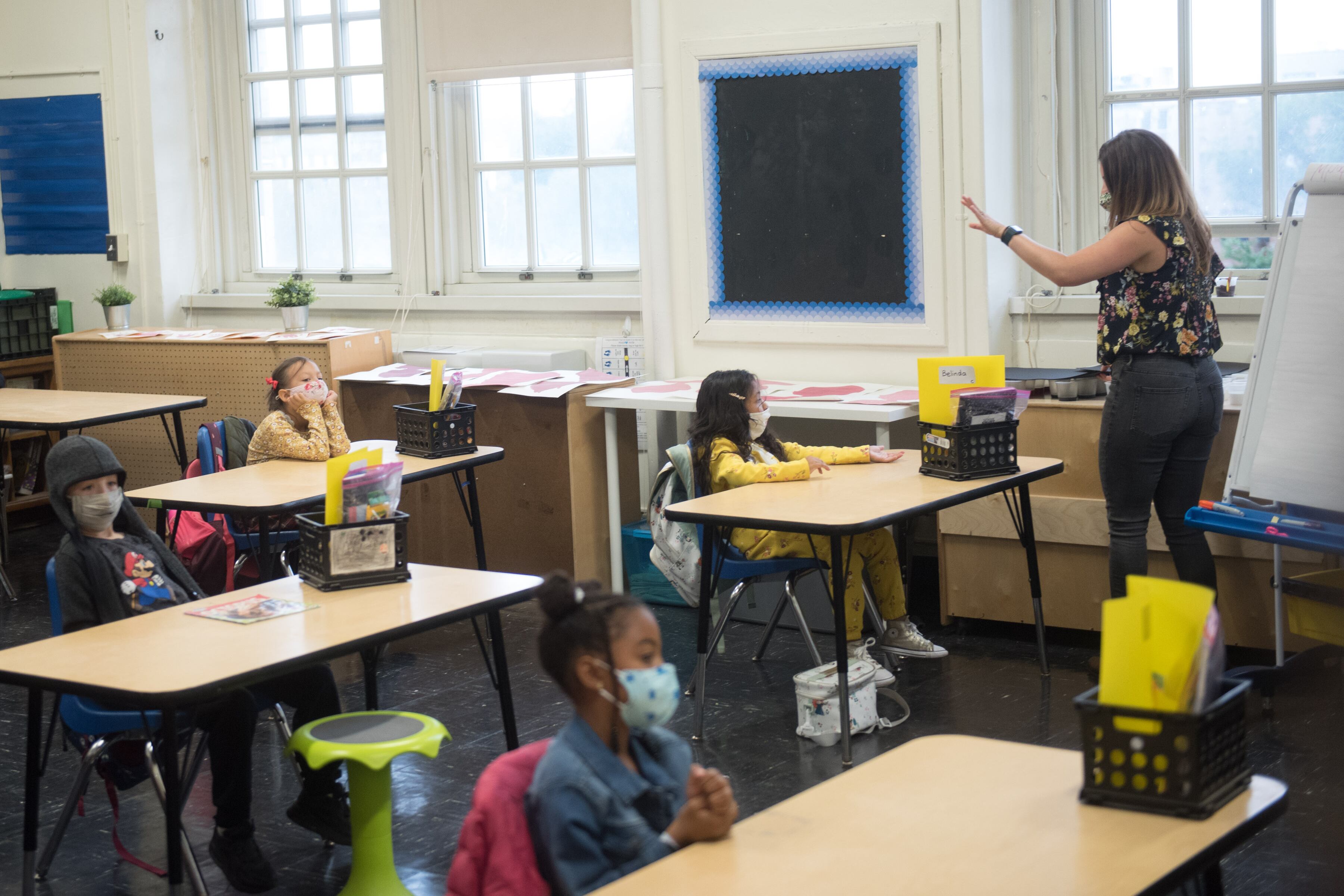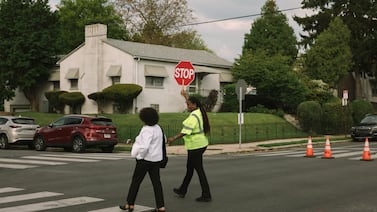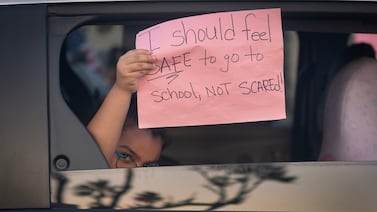Art teacher Jake Jacobs feels more like a detective most mornings.
As his co-teacher kicks off the day’s remote lesson with the students who have managed to log on, Jacobs tries tracking down those who are missing. He works through a growing list of phone numbers he has collected from parents and grandparents, aunties, and even older siblings who have already graduated from the northeast Bronx middle school where Jacobs works.
“It’s a full-time job, finding them,” he said. “I have so many contacts now, just sprawling up and down the page. But you’re just trying to figure out, where are these kids?”
More than a month into the new school year, New York City has yet to release attendance figures, making it hard to know whether students are learning — or how they’re faring mentally or physically during the ongoing coronavirus pandemic.
In a typical year, the city publishes attendance rates online each day. This year, Mayor Bill de Blasio has blamed the delay on the complications of taking roll for two versions of school. Fifty-four percent of city public school students are learning online full-time, as of Oct. 16, while the rest alternate between days inside school buildings and those learning from home. Schools, meanwhile, are grappling with the complicated nature of taking attendance during a year when “being present” is still murky, and getting kids to show up can also be a struggle.
The education department said 86% of the city’s students this past spring had some sort of daily interaction with their school — which could mean that they answered a teacher’s phone call or text message, submitted work online, or attended a virtual class. At that rate, an average of about 140,000 students a day failed to engage in school when campuses were closed between April and June. Before the pandemic, the city’s average daily attendance was much higher, around 92% in recent years, meaning some 80,000 students were absent on any given day.
‘They’re not attending regularly’
Not many students are coming to the building where Will Ehrenfeld teaches 10th grade history at P-Tech in Brooklyn’s Crown Heights.
New York City’s hybrid model, with students learning remotely and in-person at the same time, created a massive staffing crunch for schools. So at P-Tech, and many other schools in the city, students sometimes learn from their computer screens even when they are in the school building. In-person attendance has steadily dwindled as more students who had enrolled in hybrid learning opt to stay home, Ehrenfeld said.
“I’ve never seen more than 20 students in a given day, and I teach five periods a day,” he said.
Online attendance has been a struggle, too. At least in the spring, Ehrenfeld had already been able to forge real-life relationships with his students before buildings shut down. Those relationships helped motivate students to log into class. This year, his attendance — whether online in or in-person — has not exceeded 30%.
When he manages to get in touch with students, the reasons for their absences are numerous. One student works overnight and doesn’t start his schoolwork until his shift ends around 3 a.m. Many don’t have reliable internet; others have had their Wi-Fi disconnected because of unpaid bills. Without the structure of a regular school day, others simply oversleep.
But a significant reason why he thinks students aren’t showing up is because it’s hard for families to keep track of when students are supposed to be in school.
“A lot of parents and kids were confused,” he said of the alternating schedules. “They’re not attending regularly. And I think a big reason is that the schedule is indecipherable.”
At M.S. 447 in Boerum Hill, Brooklyn, students start their virtual school day in “packs” — small groups of classmates who meet for a 15-minute teacher-led orientation and daily attendance check.
The small groups make it more manageable to keep track of who’s logging in and to follow-up with anyone who’s missing, said Noah Garcia, who teaches English to remote sixth graders at the school. But she still hasn’t figured out how to track attendance for her English classes each day, with a small window of time to interact with her students.
Without that class-level data across the school, it’s hard to track trends, like whether a student is consistently missing on a certain day, and help turn things around, she said noting: “If we want to make sure that our kids are participating and being effective and make sure we’re reaching out to our kids, then we should know.”
Data from the spring, when schools went fully remote, revealed troubling patterns, with significantly higher absenteeism rates at schools with predominantly Black and Hispanic students. It’s especially consequential because chronic absenteeism is linked to higher dropout rates, and poor attendance has been used to screen out students for selective middle and high schools.
Taking roll: It’s complicated
This year, schools must track attendance in four different ways: present or absent for in-person instruction, or present or absent for remote classes.
“It’s extremely complicated,” said Miriam Altman, co-founder of a six-year-old company called Kinvolved, which provides attendance tracking software to about 250 New York City schools and recently held free professional development sessions to help schools across the five boroughs understand how to track attendance. “It can take hours and hours.”
Education department spokesman Nathaniel Styer said the city’s attendance system was created in consultation with school staff and based on their preferences. He added that the department would begin reporting numbers after schools have had a chance to be trained on the procedures and troubleshoot problems with the system.
“School leaders are closely monitoring student attendance with their staff and we will be able to report accurate, regular numbers in October,” he said.
The other complicating factor is how to define whether a remote student is present. A student might skip a large Zoom meeting, but thrive in smaller ones. A student might show up to an online class session, but not complete any assignments. Some schools might take live attendance for all students at a given time of day, as they did pre-pandemic. Others might give their remote students until 4 p.m., the deadline for submitting attendance to the education department, to mark themselves as present.
In guidance sent to principals this August, the education department encourages schools to be flexible when it comes to taking roll for remote classes.
“Parent schedules, availability of technology or other barriers may preclude students from connecting with teachers at a certain time,” the guidance notes.
Success stories
There have been some success stories. At KIPP Infinity in Harlem, attendance this year has held steady around 98% every day, said Lauren Abramson, director of operations at the charter school.
The charter network is offering remote-only instruction, and made a push to get every student a device. Internet access has been a higher hurdle, but since KIPP handed out hotspots and as of last week, all but two students had managed to get connected.
KIPP Infinity has also dedicated time to teaching parents and their students how to navigate the online platforms their teachers are using, with pre-recorded videos in English and Spanish. Teachers are also working hard to give students interesting and interactive content so that they want to show up. And when students still struggle to show up, the school relies on connections with families to try to brainstorm solutions, which can be as simple as making sure a parent is aware of their child’s online schedule.
“It’s a huge task — and it’s really important,” Abramson said of keeping attendance high. “Obviously attendance is a huge component of learning, whether in person or remote.”
In Brownsville, Brooklyn, English teacher Bijoun Eric Jordan said his high schoolers have been more motivated to come to school in person after a long quarantine. His in-person attendance has actually improved, he said, from around 70% in a typical year, up to 80% so far this year.
Jordan recently gave students a quick assignment that asked what kept them coming to the building. One wrote that it felt more “normal” to be in school. Another said it was easier to get work done, and yet another just wanted to “get out of the house.”
“There have been generally positive vibes for the students who are there,” Jordan said. “[School] is a place of stability. It is a sense of normalcy, and I think the students can sense that.”






